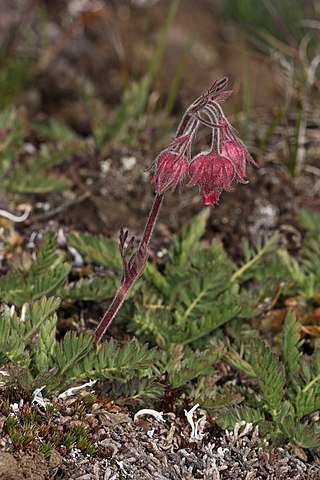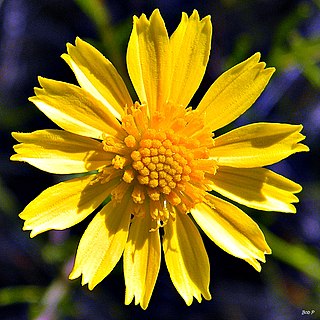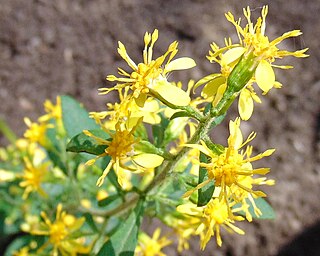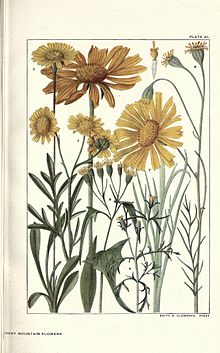
Eriophyllum lanatum, with the common names common woolly sunflower, Oregon sunshine and golden yarrow, is a common, widespread, North American plant in the family Asteraceae.

Grindelia squarrosa, also known as a curly-top gumweed or curlycup gumweed, is a small North American biennial or short-lived perennial plant.

Geum triflorum, commonly known as prairie smoke, old man's whiskers, torchflower, three-sisters, long-plumed purple avens, lion's beard, or three-flowered avens, is a spring-blooming perennial herbaceous plant of the Rosaceae family. It is a hemiboreal continental climate species that is widespread in colder and drier environments of western North America, although it does occur in isolated populations as far east as New York and Ontario. It is particularly known for the long feathery plumes on the seed heads that have inspired many of the regional common names and aid in wind dispersal of its seeds.

Erigeron compositus is an Arctic and alpine species of fleabane in the family Asteraceae. Common names include dwarf mountain fleabane, cutleaf daisy, and trifid mountain fleabane.

Gaillardia aristata is a North American species of flowering plant in the sunflower family, known by the common names common blanketflower and common gaillardia. This perennial wildflower is widespread across much of North America, from Yukon east to Québec and south as far as California, Arizona, Illinois, and Connecticut, although it may be naturalized rather than native in parts of that range. It is also naturalized in scattered locations in Europe, Australia, and South America.

Hymenopappus is a genus of flowering plants in the daisy family. Many species are known as woollywhites.

Balsamorhiza sagittata is a North American species of flowering plant in the tribe Heliantheae of the family Asteraceae known by the common name Arrowleaf Balsamroot. Also sometimes called Oregon sunflower, it is widespread across western Canada and much of the western United States.

Artemisia cana is a species of sagebrush native to western and central North America; it is a member of the sunflower family. It is known by many common names, including silver sagebrush, sticky sagebrush, silver wormwood, hoary sagebrush, and dwarf sagebrush.
Smilax walteri, common names coral greenbrier, red-berried greenbrier or red-berried bamboo, is a North American species of plant found only in the United States. It is native to coastal plains in the south-central, southeastern, and east-central parts of the country, from eastern Texas to New Jersey.

Balduina angustifolia, the coastal plain honeycombhead, is a North American species of plants in the sunflower family. It is native to the southeastern United States.

Solidago macrophylla, the largeleaf goldenrod or large-leaved goldenrod, is North American species of herbaceous perennial plants of the family Asteraceae. It is native to eastern and central Canada and the north-eastern United States. Some of the populations in Québec and Labrador lie north of the Arctic Circle.

Heterotheca villosa, commonly known as the hairy goldenaster, is a species of flowering plant in the family Asteraceae found in central and western North America.

Hymenopappus artemisiifolius, the oldplainsman, is a North American species of flowering plant in the daisy family. It has been found only in the south-central United States, in Texas, Arkansas, and Louisiana. Its natural habitat is in sandy soils of prairies and open woodlands.
Hymenopappus biennis, the biennial woollywhite, is a North American species of flowering plant in the daisy family. It has been found in New Mexico and western Texas.
Hymenopappus carrizoanus, the Carrizo Sands woollywhite, is a North American species of flowering plant in the daisy family. It has been found only in Texas, on the Carrizo Sands of the central part of the state.
Hymenopappus flavescens, the collegeflower, is a North American species of flowering plant in the daisy family.

Hymenopappus scabiosaeus, the Carolina woollywhite, is a North American species of flowering plant in the daisy family. It grows in the central and southeastern United States, primarily on the Great Plains an on the Coastal Plain of the Southeast. There are also isolated populations in Illinois and Indiana as well as in the state of Coahuila in northern Mexico.

Iva axillaris, called povertyweed or death weed, is a North American species of flowering plants in the family Asteraceae. It grows in the western and central United States and in western Canada, from British Columbia south to California and east as far as the western Great Plains in the Texas Panhandle, Nebraska, the Dakotas, and Manitoba. It has also become established in Australia, where it is considered a weed.

Mertensia lanceolata, known as prairie bluebells, narrow-leaved languid lady, lance-leaved bluebells, and lance-leaved lungwort is a species of flowering plant native to western North America. A herbaceous perennial it has blue-green leaves alternately arranged on its smooth flowering stalk. Its flower buds are pink-purple and become more blue as they open. Accepted varieties include:

Platanthera dilatata, known as tall white bog orchid, bog candle, or boreal bog orchid is a species of orchid, a flowering plant in the family Orchidaceae, native to North America. It was first formally described in 1813 by Frederick Traugott Pursh as Orchis dilatata.

















